tire size BMW 750LI XDRIVE 2013 Owners Manual
[x] Cancel search | Manufacturer: BMW, Model Year: 2013, Model line: 750LI XDRIVE, Model: BMW 750LI XDRIVE 2013Pages: 243, PDF Size: 5.37 MB
Page 109 of 243

MalfunctionThe yellow warning lamp flashes and
then lights up continuously. A Check
Control message is displayed. No flat
tire can be detected.
Display in the following situations:▷A wheel without TPM electronics is fitted:
have the service center check it if necessary.▷Malfunction: have the system checked by
your service center.▷TPM could not be fully reset. Reset the sys‐
tem again.▷Disturbance by systems or devices with the
same radio frequency: after leaving the area
of the disturbance, the system automatically
becomes active again.
Declaration according to NHTSA/
FMVSS 138 Tire Pressure Monitoring
System
Each tire, including the spare (if provided)
should be checked monthly when cold and in‐
flated to the inflation pressure recommended by
the vehicle manufacturer on the vehicle placard
or tire inflation pressure label. (If your vehicle has
tires of a different size than the size indicated on
the vehicle placard or tire inflation pressure la‐
bel, you should determine the proper tire infla‐
tion pressure for those tires.) As an added safety
feature, your vehicle has been equipped with a
tire pressure monitoring system (TPMS) that il‐
luminates a low tire pressure telltale when one
or more of your tires is significantly under-in‐
flated. Accordingly, when the low tire pressure
telltale illuminates, you should stop and check
your tires as soon as possible, and inflate them
to the proper pressure. Driving on a significantly
under-inflated tire causes the tire to overheat
and can lead to tire failure. Under-inflation also
reduces fuel efficiency and tire tread life, and
may affect the vehicle's handling and stopping
ability. Please note that the TPMS is not a sub‐
stitute for proper tire maintenance, and it is the
driver's responsibility to maintain correct tire
pressure, even if under-inflation has not reached
the level to trigger illumination of the TPMS low
tire pressure telltale. Your vehicle has also been
equipped with a TPMS malfunction indicator to
indicate when the system is not operating prop‐
erly. The TPMS malfunction indicator is com‐
bined with the low tire pressure telltale. When
the system detects a malfunction, the telltale will
flash for approximately one minute and then re‐
main continuously illuminated. This sequence
will continue upon subsequent vehicle start-ups
as long as the malfunction exists. When the mal‐
function indicator is illuminated, the system may
not be able to detect or signal low tire pressure
as intended. TPMS malfunctions may occur for
a variety of reasons, including the installation of
replacement or alternate tires or wheels on the
vehicle that prevent the TPMS from functioning
properly. Always check the TPMS malfunction
telltale after replacing one or more tires or
wheels on your vehicle to ensure that the re‐
placement or alternate tires and wheels allow
the TPMS to continue to function properly.
Intelligent Safety
The concept
Depending on how the vehicle is equipped, In‐
telligent Safety consists of one or more of the
following systems, which can help to avoid an
imminent collision. These systems are switched
on automatically every time the engine is started
using the Start/Stop button:▷Collision warning with braking function, re‐
fer to page 112▷Night Vision with pedestrian detection, refer
to page 114.
Note
Personal responsibility
The system does not serve as a substitute
for the driver's personal judgment of the traffic
situation.
Seite 109SafetyControls109
Online Edition for Part no. 01 40 2 916 693 - X/12
Page 180 of 243
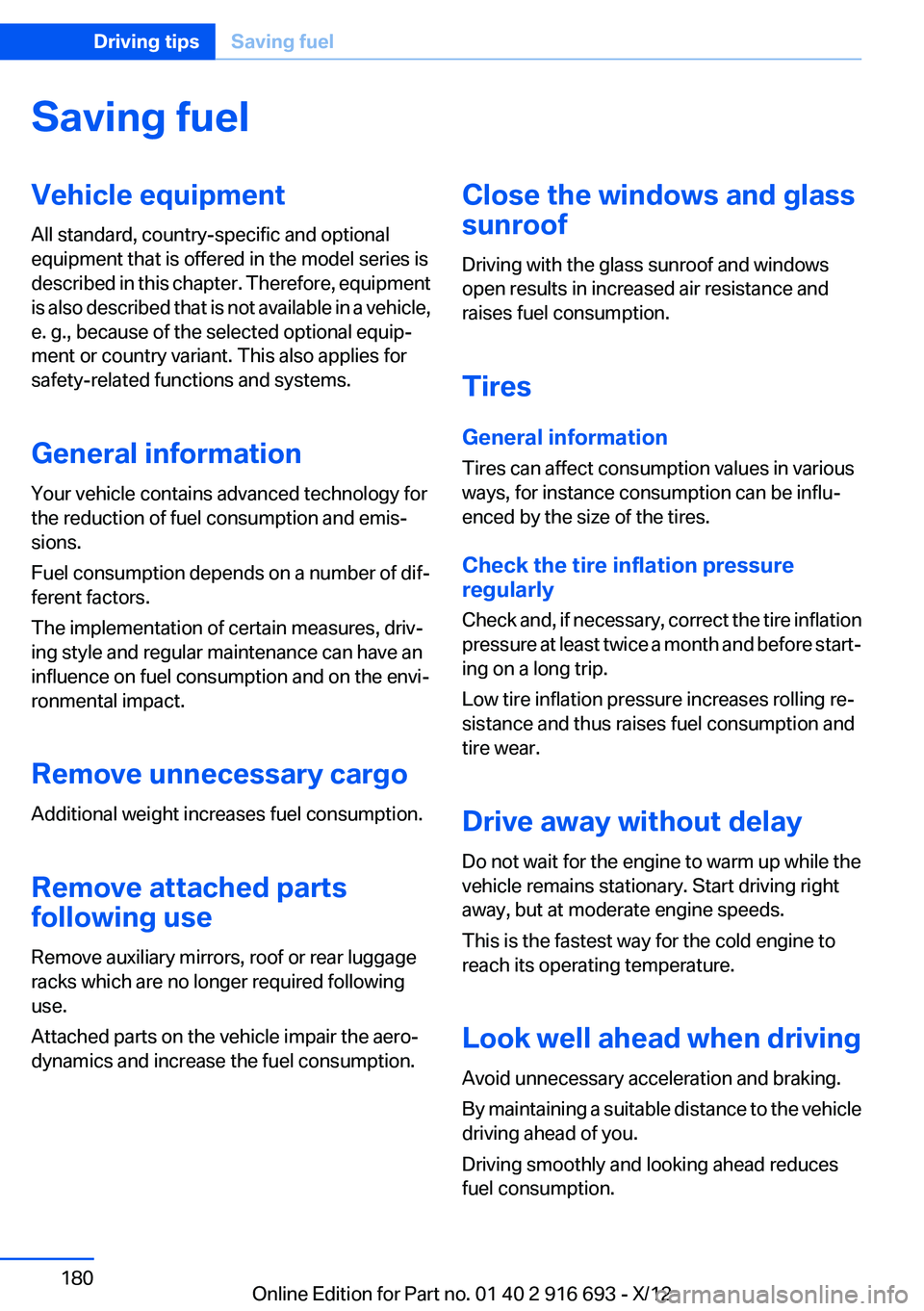
Saving fuelVehicle equipment
All standard, country-specific and optional
equipment that is offered in the model series is
described in this chapter. Therefore, equipment
is also described that is not available in a vehicle,
e. g., because of the selected optional equip‐
ment or country variant. This also applies for
safety-related functions and systems.
General information
Your vehicle contains advanced technology for
the reduction of fuel consumption and emis‐
sions.
Fuel consumption depends on a number of dif‐
ferent factors.
The implementation of certain measures, driv‐
ing style and regular maintenance can have an
influence on fuel consumption and on the envi‐
ronmental impact.
Remove unnecessary cargo
Additional weight increases fuel consumption.
Remove attached parts
following use
Remove auxiliary mirrors, roof or rear luggage
racks which are no longer required following
use.
Attached parts on the vehicle impair the aero‐
dynamics and increase the fuel consumption.Close the windows and glass
sunroof
Driving with the glass sunroof and windows
open results in increased air resistance and
raises fuel consumption.
Tires
General information
Tires can affect consumption values in various
ways, for instance consumption can be influ‐
enced by the size of the tires.
Check the tire inflation pressure
regularly
Check and, if necessary, correct the tire inflation
pressure at least twice a month and before start‐
ing on a long trip.
Low tire inflation pressure increases rolling re‐
sistance and thus raises fuel consumption and
tire wear.
Drive away without delay
Do not wait for the engine to warm up while the
vehicle remains stationary. Start driving right
away, but at moderate engine speeds.
This is the fastest way for the cold engine to
reach its operating temperature.
Look well ahead when driving
Avoid unnecessary acceleration and braking.
By maintaining a suitable distance to the vehicle
driving ahead of you.
Driving smoothly and looking ahead reduces
fuel consumption.Seite 180Driving tipsSaving fuel180
Online Edition for Part no. 01 40 2 916 693 - X/12
Page 191 of 243
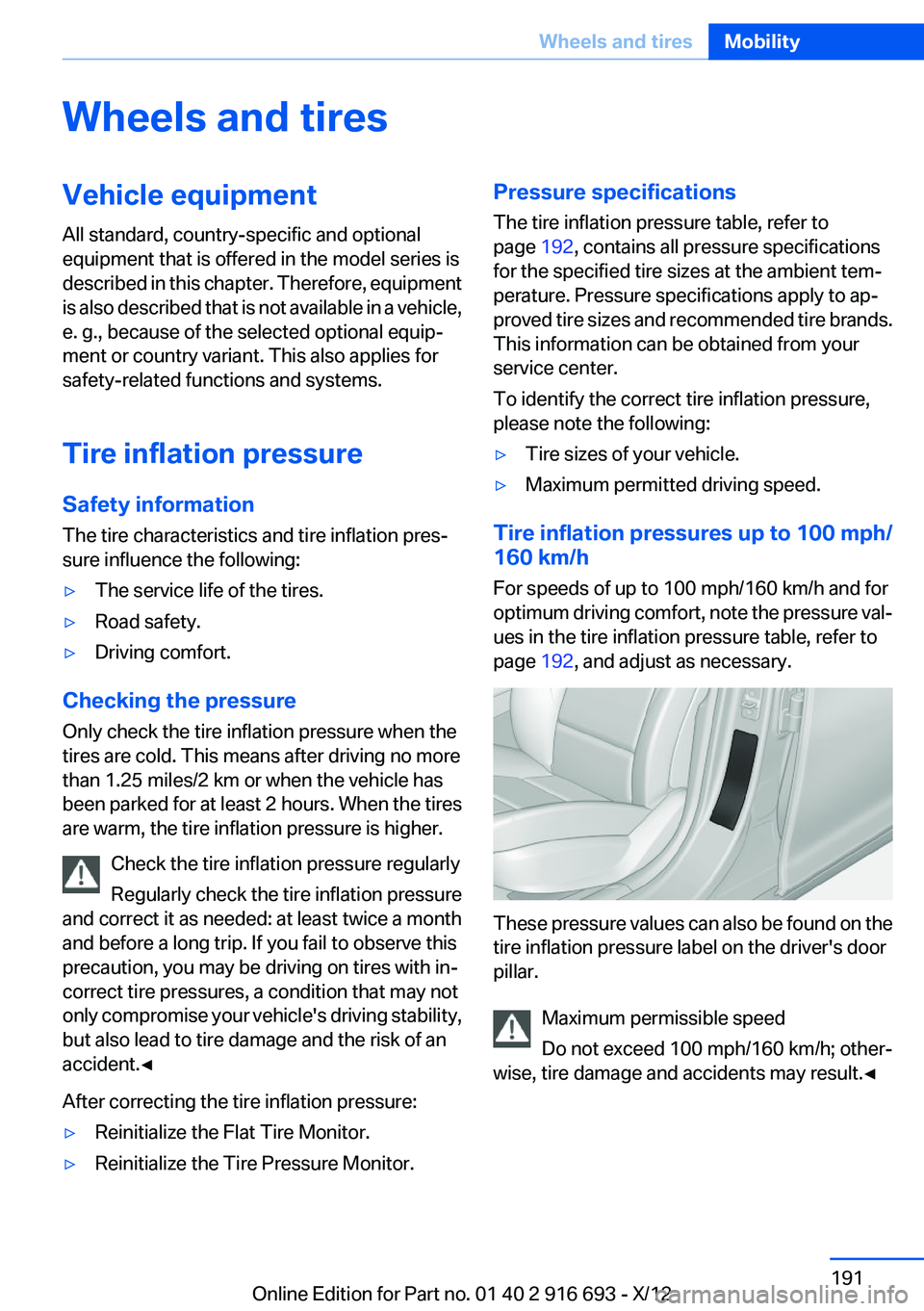
Wheels and tiresVehicle equipment
All standard, country-specific and optional
equipment that is offered in the model series is
described in this chapter. Therefore, equipment
is also described that is not available in a vehicle,
e. g., because of the selected optional equip‐
ment or country variant. This also applies for
safety-related functions and systems.
Tire inflation pressure
Safety information
The tire characteristics and tire inflation pres‐
sure influence the following:▷The service life of the tires.▷Road safety.▷Driving comfort.
Checking the pressure
Only check the tire inflation pressure when the
tires are cold. This means after driving no more
than 1.25 miles/2 km or when the vehicle has
been parked for at least 2 hours. When the tires
are warm, the tire inflation pressure is higher.
Check the tire inflation pressure regularly
Regularly check the tire inflation pressure
and correct it as needed: at least twice a month
and before a long trip. If you fail to observe this
precaution, you may be driving on tires with in‐
correct tire pressures, a condition that may not
only compromise your vehicle's driving stability,
but also lead to tire damage and the risk of an
accident.◀
After correcting the tire inflation pressure:
▷Reinitialize the Flat Tire Monitor.▷Reinitialize the Tire Pressure Monitor.Pressure specifications
The tire inflation pressure table, refer to
page 192, contains all pressure specifications
for the specified tire sizes at the ambient tem‐
perature. Pressure specifications apply to ap‐
proved tire sizes and recommended tire brands.
This information can be obtained from your
service center.
To identify the correct tire inflation pressure,
please note the following:▷Tire sizes of your vehicle.▷Maximum permitted driving speed.
Tire inflation pressures up to 100 mph/
160 km/h
For speeds of up to 100 mph/160 km/h and for
optimum driving comfort, note the pressure val‐
ues in the tire inflation pressure table, refer to
page 192, and adjust as necessary.
These pressure values can also be found on the
tire inflation pressure label on the driver's door
pillar.
Maximum permissible speed
Do not exceed 100 mph/160 km/h; other‐
wise, tire damage and accidents may result.◀
Seite 191Wheels and tiresMobility191
Online Edition for Part no. 01 40 2 916 693 - X/12
Page 192 of 243
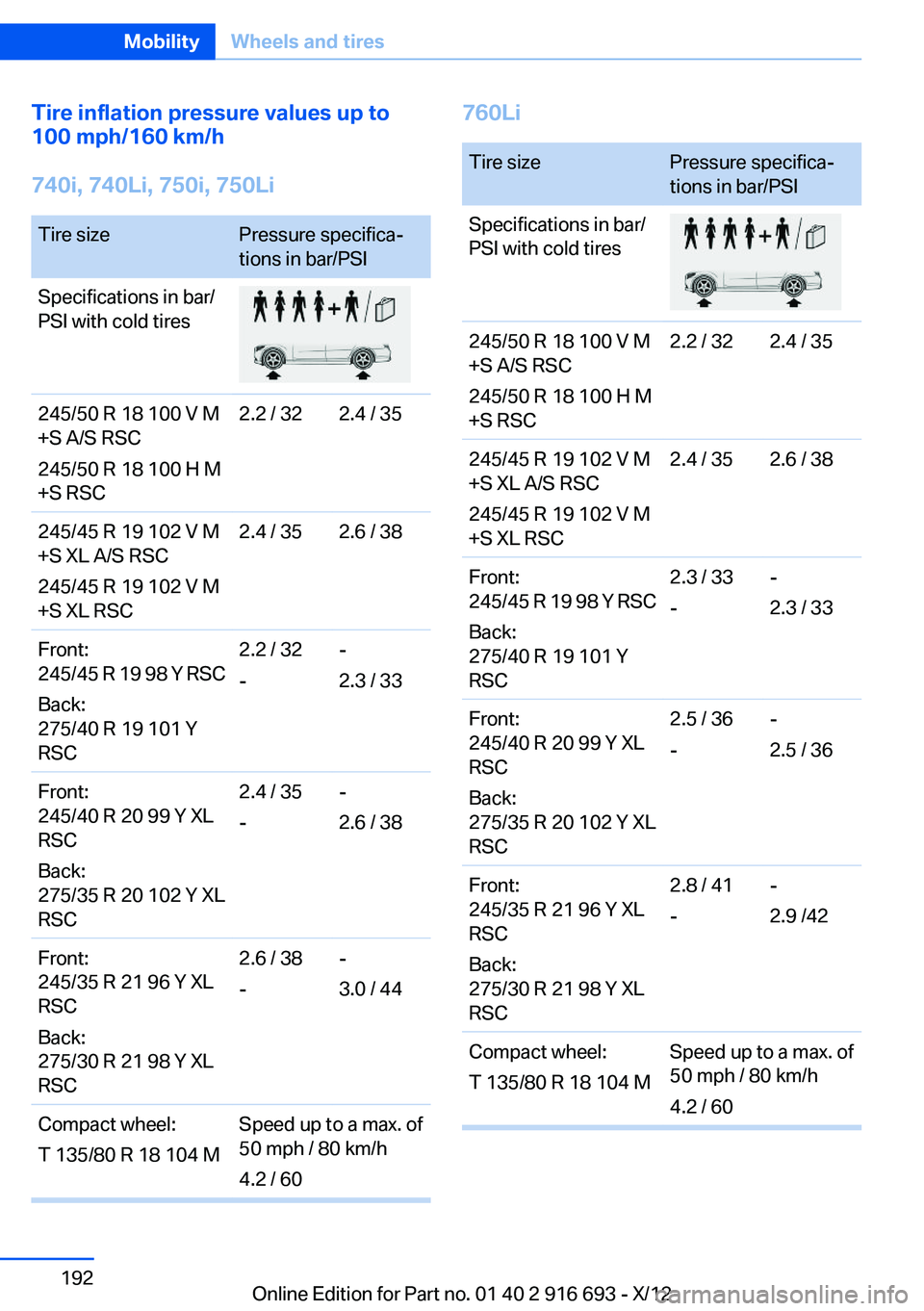
Tire inflation pressure values up to
100 mph/160 km/h
740i, 740Li, 750i, 750LiTire sizePressure specifica‐
tions in bar/PSISpecifications in bar/
PSI with cold tires245/50 R 18 100 V M
+S A/S RSC
245/50 R 18 100 H M
+S RSC2.2 / 322.4 / 35245/45 R 19 102 V M
+S XL A/S RSC
245/45 R 19 102 V M
+S XL RSC2.4 / 352.6 / 38Front:
245/45 R 19 98 Y RSC
Back:
275/40 R 19 101 Y
RSC2.2 / 32
--
2.3 / 33Front:
245/40 R 20 99 Y XL
RSC
Back:
275/35 R 20 102 Y XL
RSC2.4 / 35
--
2.6 / 38Front:
245/35 R 21 96 Y XL
RSC
Back:
275/30 R 21 98 Y XL
RSC2.6 / 38
--
3.0 / 44Compact wheel:
T 135/80 R 18 104 MSpeed up to a max. of
50 mph / 80 km/h
4.2 / 60760LiTire sizePressure specifica‐
tions in bar/PSISpecifications in bar/
PSI with cold tires245/50 R 18 100 V M
+S A/S RSC
245/50 R 18 100 H M
+S RSC2.2 / 322.4 / 35245/45 R 19 102 V M
+S XL A/S RSC
245/45 R 19 102 V M
+S XL RSC2.4 / 352.6 / 38Front:
245/45 R 19 98 Y RSC
Back:
275/40 R 19 101 Y
RSC2.3 / 33
--
2.3 / 33Front:
245/40 R 20 99 Y XL
RSC
Back:
275/35 R 20 102 Y XL
RSC2.5 / 36
--
2.5 / 36Front:
245/35 R 21 96 Y XL
RSC
Back:
275/30 R 21 98 Y XL
RSC2.8 / 41
--
2.9 /42Compact wheel:
T 135/80 R 18 104 MSpeed up to a max. of
50 mph / 80 km/h
4.2 / 60Seite 192MobilityWheels and tires192
Online Edition for Part no. 01 40 2 916 693 - X/12
Page 193 of 243
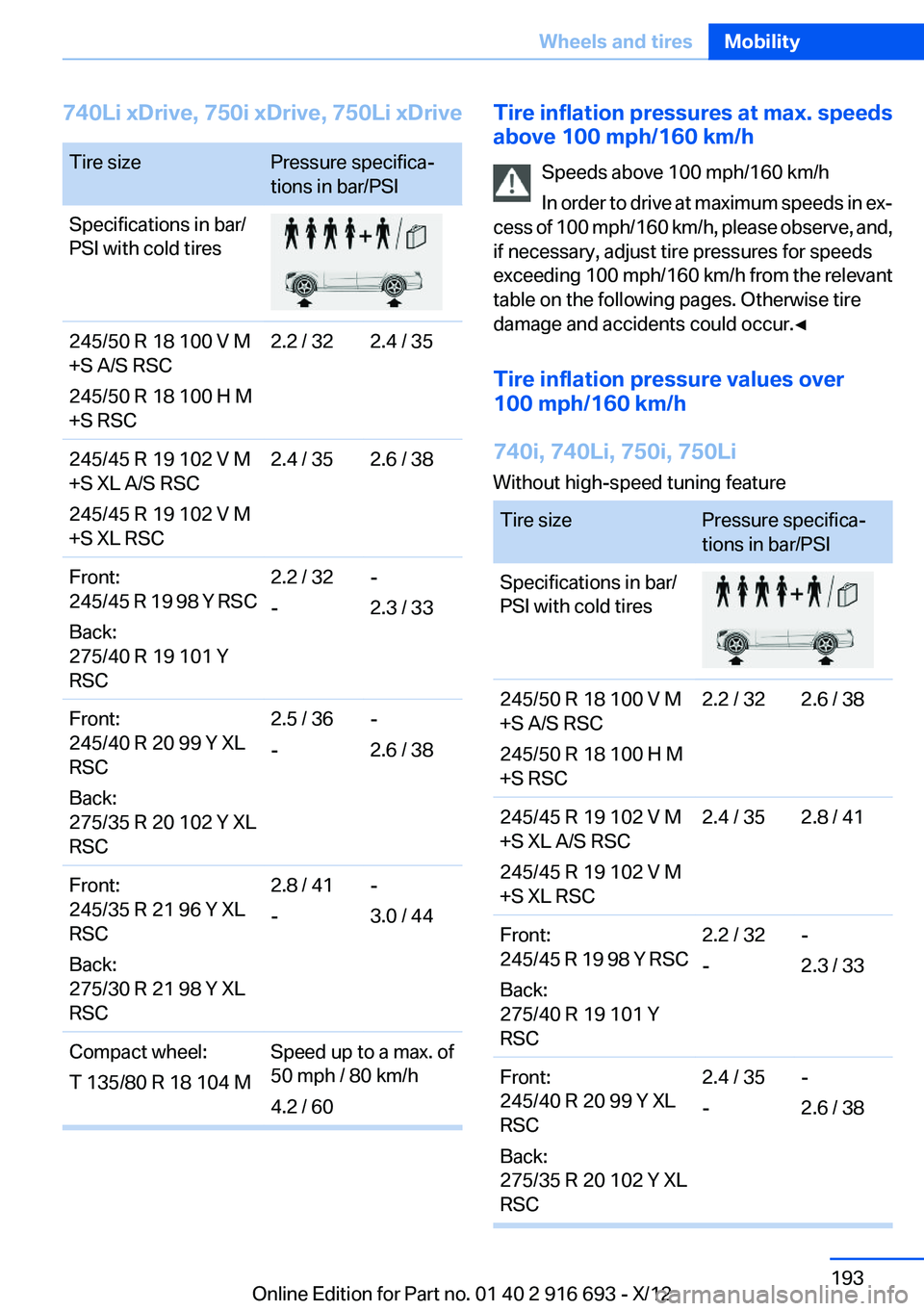
740Li xDrive, 750i xDrive, 750Li xDriveTire sizePressure specifica‐
tions in bar/PSISpecifications in bar/
PSI with cold tires245/50 R 18 100 V M
+S A/S RSC
245/50 R 18 100 H M
+S RSC2.2 / 322.4 / 35245/45 R 19 102 V M
+S XL A/S RSC
245/45 R 19 102 V M
+S XL RSC2.4 / 352.6 / 38Front:
245/45 R 19 98 Y RSC
Back:
275/40 R 19 101 Y
RSC2.2 / 32
--
2.3 / 33Front:
245/40 R 20 99 Y XL
RSC
Back:
275/35 R 20 102 Y XL
RSC2.5 / 36
--
2.6 / 38Front:
245/35 R 21 96 Y XL
RSC
Back:
275/30 R 21 98 Y XL
RSC2.8 / 41
--
3.0 / 44Compact wheel:
T 135/80 R 18 104 MSpeed up to a max. of
50 mph / 80 km/h
4.2 / 60Tire inflation pressures at max. speeds
above 100 mph/160 km/h
Speeds above 100 mph/160 km/h
In order to drive at maximum speeds in ex‐
cess of 100 mph/160 km/h, please observe, and,
if necessary, adjust tire pressures for speeds
exceeding 100 mph/160 km/h from the relevant
table on the following pages. Otherwise tire
damage and accidents could occur.◀
Tire inflation pressure values over
100 mph/160 km/h
740i, 740Li, 750i, 750Li
Without high-speed tuning featureTire sizePressure specifica‐
tions in bar/PSISpecifications in bar/
PSI with cold tires245/50 R 18 100 V M
+S A/S RSC
245/50 R 18 100 H M
+S RSC2.2 / 322.6 / 38245/45 R 19 102 V M
+S XL A/S RSC
245/45 R 19 102 V M
+S XL RSC2.4 / 352.8 / 41Front:
245/45 R 19 98 Y RSC
Back:
275/40 R 19 101 Y
RSC2.2 / 32
--
2.3 / 33Front:
245/40 R 20 99 Y XL
RSC
Back:
275/35 R 20 102 Y XL
RSC2.4 / 35
--
2.6 / 38Seite 193Wheels and tiresMobility193
Online Edition for Part no. 01 40 2 916 693 - X/12
Page 194 of 243
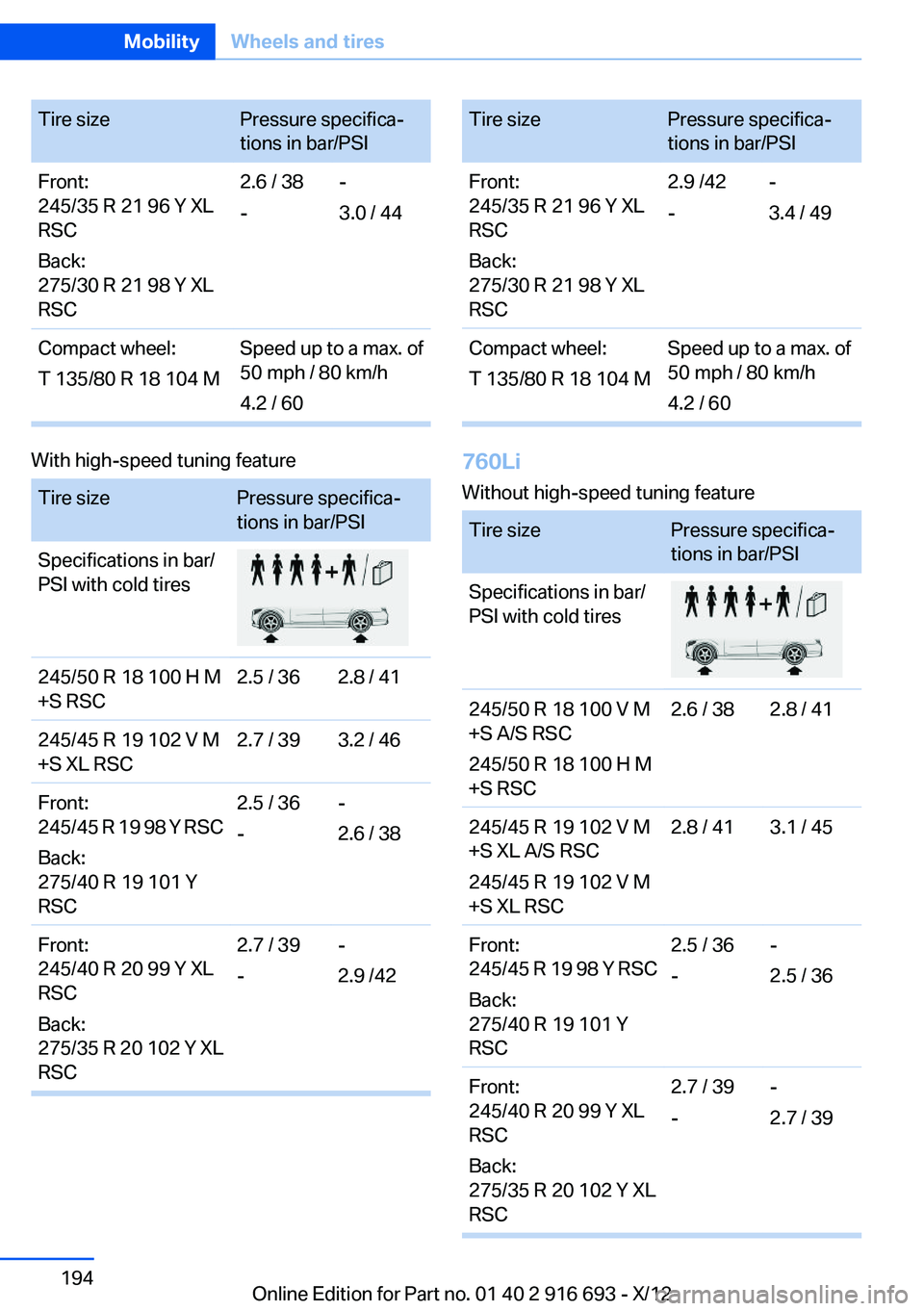
Tire sizePressure specifica‐
tions in bar/PSIFront:
245/35 R 21 96 Y XL
RSC
Back:
275/30 R 21 98 Y XL
RSC2.6 / 38
--
3.0 / 44Compact wheel:
T 135/80 R 18 104 MSpeed up to a max. of
50 mph / 80 km/h
4.2 / 60
With high-speed tuning feature
Tire sizePressure specifica‐
tions in bar/PSISpecifications in bar/
PSI with cold tires245/50 R 18 100 H M
+S RSC2.5 / 362.8 / 41245/45 R 19 102 V M
+S XL RSC2.7 / 393.2 / 46Front:
245/45 R 19 98 Y RSC
Back:
275/40 R 19 101 Y
RSC2.5 / 36
--
2.6 / 38Front:
245/40 R 20 99 Y XL
RSC
Back:
275/35 R 20 102 Y XL
RSC2.7 / 39
--
2.9 /42Tire sizePressure specifica‐
tions in bar/PSIFront:
245/35 R 21 96 Y XL
RSC
Back:
275/30 R 21 98 Y XL
RSC2.9 /42
--
3.4 / 49Compact wheel:
T 135/80 R 18 104 MSpeed up to a max. of
50 mph / 80 km/h
4.2 / 60
760Li
Without high-speed tuning feature
Tire sizePressure specifica‐
tions in bar/PSISpecifications in bar/
PSI with cold tires245/50 R 18 100 V M
+S A/S RSC
245/50 R 18 100 H M
+S RSC2.6 / 382.8 / 41245/45 R 19 102 V M
+S XL A/S RSC
245/45 R 19 102 V M
+S XL RSC2.8 / 413.1 / 45Front:
245/45 R 19 98 Y RSC
Back:
275/40 R 19 101 Y
RSC2.5 / 36
--
2.5 / 36Front:
245/40 R 20 99 Y XL
RSC
Back:
275/35 R 20 102 Y XL
RSC2.7 / 39
--
2.7 / 39Seite 194MobilityWheels and tires194
Online Edition for Part no. 01 40 2 916 693 - X/12
Page 195 of 243

Tire sizePressure specifica‐
tions in bar/PSIFront:
245/35 R 21 96 Y XL
RSC
Back:
275/30 R 21 98 Y XL
RSC3.0 / 44
--
3.1 / 45Compact wheel:
T 135/80 R 18 104 MSpeed up to a max. of
50 mph / 80 km/h
4.2 / 60
With high-speed tuning feature
Tire sizePressure specifica‐
tions in bar/PSISpecifications in bar/
PSI with cold tires245/50 R 18 100 H M
+S RSC2.6 / 382.8 / 41245/45 R 19 102 V M
+S XL RSC2.8 / 413.1 / 45Front:
245/45 R 19 98 Y RSC
Back:
275/40 R 19 101 Y
RSC2.6 / 38
--
2.6 / 38Front:
245/40 R 20 99 Y XL
RSC
Back:
275/35 R 20 102 Y XL
RSC2.8 / 41
--
2.8 / 41Tire sizePressure specifica‐
tions in bar/PSIFront:
245/35 R 21 96 Y XL
RSC
Back:
275/30 R 21 98 Y XL
RSC3.2 / 46
--
3.2 / 46Compact wheel:
T 135/80 R 18 104 MSpeed up to a max. of
50 mph / 80 km/h
4.2 / 60
750Li xDrive, 750i xDrive, 750Li xDrive
Without high-speed tuning feature
Tire sizePressure specifica‐
tions in bar/PSISpecifications in bar/
PSI with cold tires245/50 R 18 100 V M
+S A/S RSC
245/50 R 18 100 H M
+S RSC2.4 / 352.6 / 38245/45 R 19 102 V M
+S XL A/S RSC
245/45 R 19 102 V M
+S XL RSC2.6 / 382.8 / 41Front:
245/45 R 19 98 Y RSC
Back:
275/40 R 19 101 Y
RSC2.2 / 32
--
2.3 / 33Front:
245/40 R 20 99 Y XL
RSC
Back:
275/35 R 20 102 Y XL
RSC2.5 / 36
--
2.6 / 38Seite 195Wheels and tiresMobility195
Online Edition for Part no. 01 40 2 916 693 - X/12
Page 196 of 243
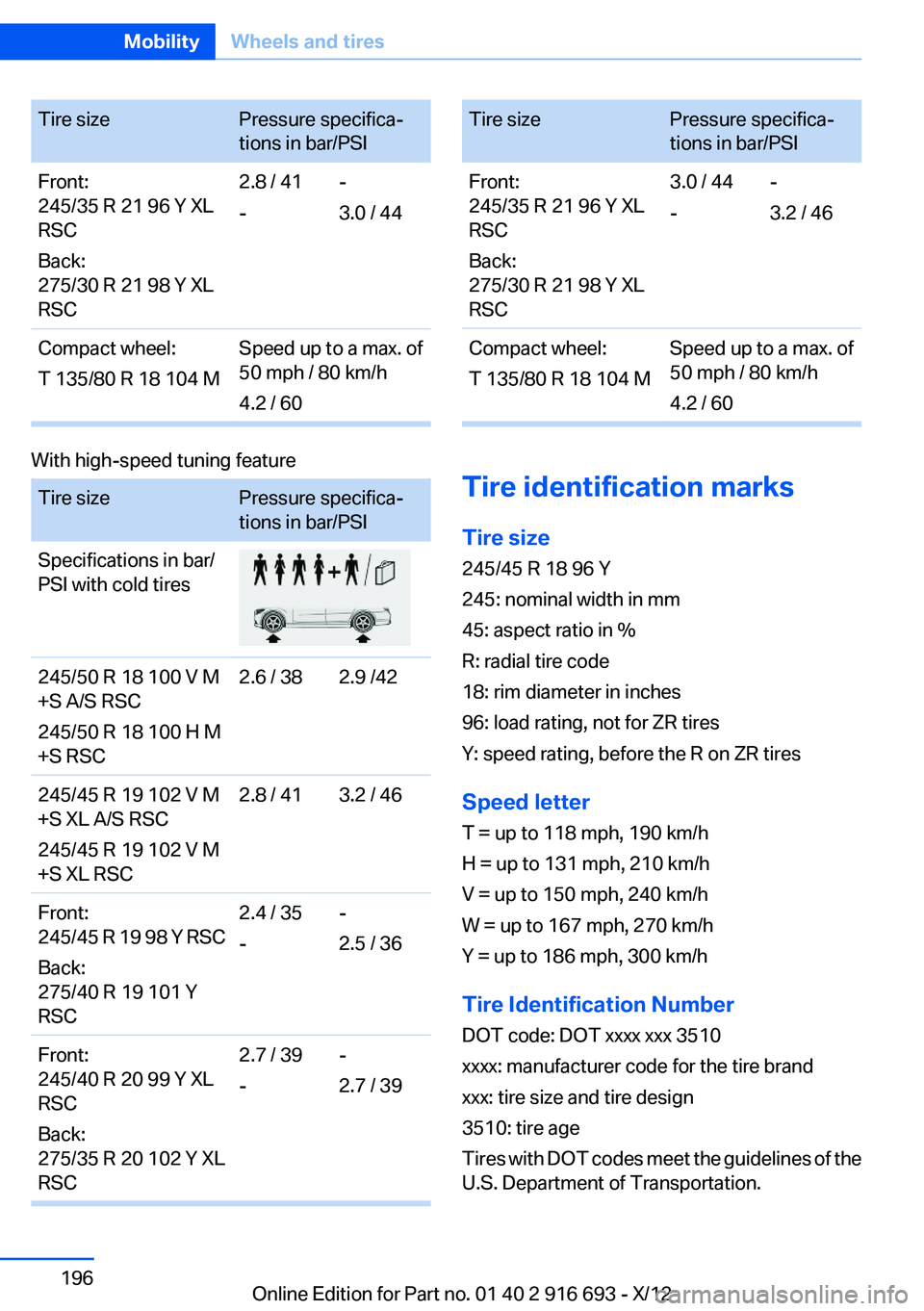
Tire sizePressure specifica‐
tions in bar/PSIFront:
245/35 R 21 96 Y XL
RSC
Back:
275/30 R 21 98 Y XL
RSC2.8 / 41
--
3.0 / 44Compact wheel:
T 135/80 R 18 104 MSpeed up to a max. of
50 mph / 80 km/h
4.2 / 60
With high-speed tuning feature
Tire sizePressure specifica‐
tions in bar/PSISpecifications in bar/
PSI with cold tires245/50 R 18 100 V M
+S A/S RSC
245/50 R 18 100 H M
+S RSC2.6 / 382.9 /42245/45 R 19 102 V M
+S XL A/S RSC
245/45 R 19 102 V M
+S XL RSC2.8 / 413.2 / 46Front:
245/45 R 19 98 Y RSC
Back:
275/40 R 19 101 Y
RSC2.4 / 35
--
2.5 / 36Front:
245/40 R 20 99 Y XL
RSC
Back:
275/35 R 20 102 Y XL
RSC2.7 / 39
--
2.7 / 39Tire sizePressure specifica‐
tions in bar/PSIFront:
245/35 R 21 96 Y XL
RSC
Back:
275/30 R 21 98 Y XL
RSC3.0 / 44
--
3.2 / 46Compact wheel:
T 135/80 R 18 104 MSpeed up to a max. of
50 mph / 80 km/h
4.2 / 60
Tire identification marks
Tire size
245/45 R 18 96 Y
245: nominal width in mm
45: aspect ratio in %
R: radial tire code
18: rim diameter in inches
96: load rating, not for ZR tires
Y: speed rating, before the R on ZR tires
Speed letter
T = up to 118 mph, 190 km/h
H = up to 131 mph, 210 km/h
V = up to 150 mph, 240 km/h
W = up to 167 mph, 270 km/h
Y = up to 186 mph, 300 km/h
Tire Identification Number
DOT code: DOT xxxx xxx 3510
xxxx: manufacturer code for the tire brand
xxx: tire size and tire design
3510: tire age
Tires with DOT codes meet the guidelines of the
U.S. Department of Transportation.
Seite 196MobilityWheels and tires196
Online Edition for Part no. 01 40 2 916 693 - X/12
Page 199 of 243
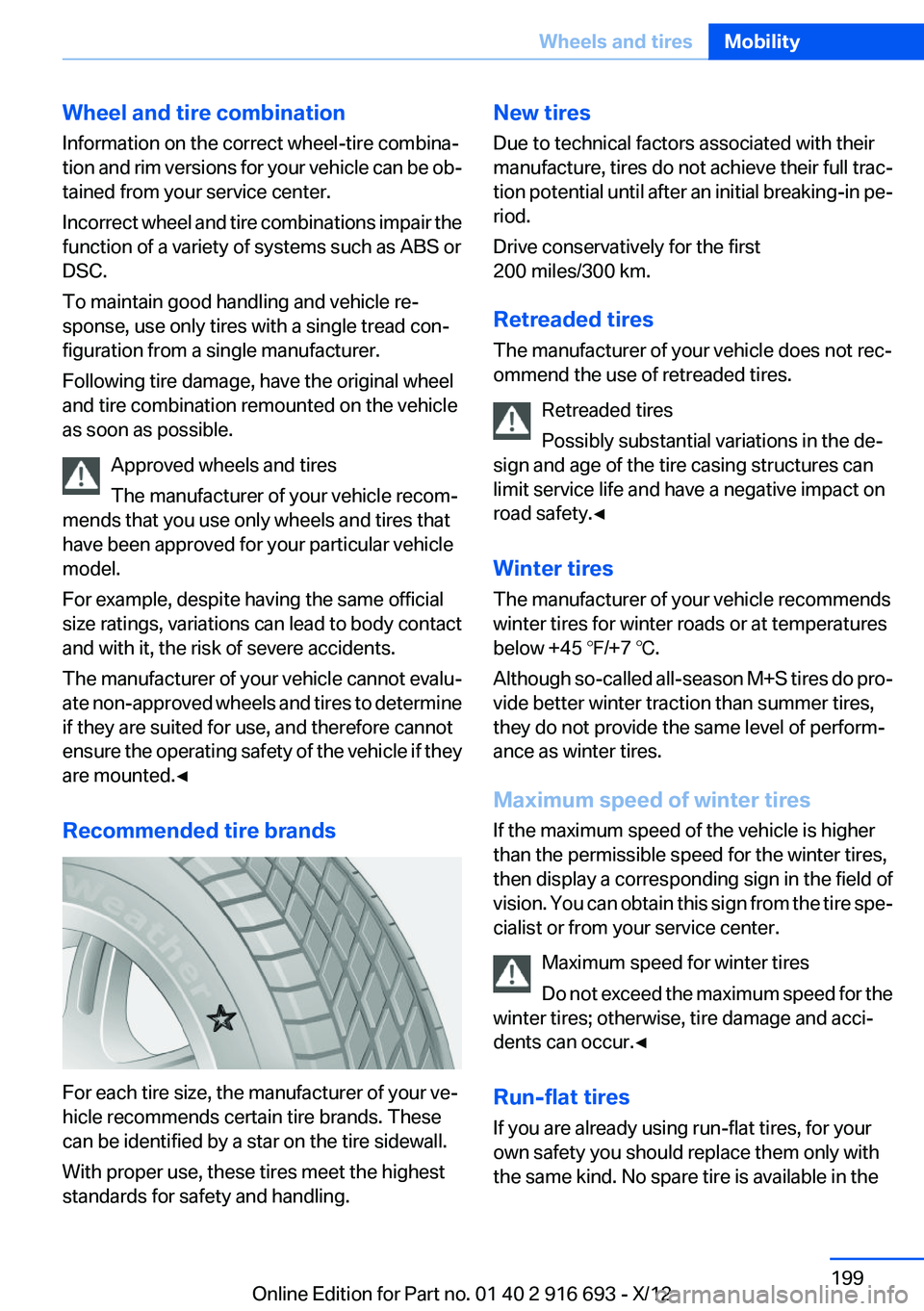
Wheel and tire combination
Information on the correct wheel-tire combina‐
tion and rim versions for your vehicle can be ob‐
tained from your service center.
Incorrect wheel and tire combinations impair the
function of a variety of systems such as ABS or
DSC.
To maintain good handling and vehicle re‐
sponse, use only tires with a single tread con‐
figuration from a single manufacturer.
Following tire damage, have the original wheel
and tire combination remounted on the vehicle
as soon as possible.
Approved wheels and tires
The manufacturer of your vehicle recom‐
mends that you use only wheels and tires that
have been approved for your particular vehicle
model.
For example, despite having the same official
size ratings, variations can lead to body contact
and with it, the risk of severe accidents.
The manufacturer of your vehicle cannot evalu‐
ate non-approved wheels and tires to determine
if they are suited for use, and therefore cannot
ensure the operating safety of the vehicle if they
are mounted.◀
Recommended tire brands
For each tire size, the manufacturer of your ve‐
hicle recommends certain tire brands. These
can be identified by a star on the tire sidewall.
With proper use, these tires meet the highest
standards for safety and handling.
New tires
Due to technical factors associated with their
manufacture, tires do not achieve their full trac‐
tion potential until after an initial breaking-in pe‐
riod.
Drive conservatively for the first
200 miles/300 km.
Retreaded tires
The manufacturer of your vehicle does not rec‐
ommend the use of retreaded tires.
Retreaded tires
Possibly substantial variations in the de‐
sign and age of the tire casing structures can
limit service life and have a negative impact on
road safety.◀
Winter tires
The manufacturer of your vehicle recommends
winter tires for winter roads or at temperatures
below +45 ℉/+7 ℃.
Although so-called all-season M+S tires do pro‐
vide better winter traction than summer tires,
they do not provide the same level of perform‐
ance as winter tires.
Maximum speed of winter tires
If the maximum speed of the vehicle is higher
than the permissible speed for the winter tires,
then display a corresponding sign in the field of
vision. You can obtain this sign from the tire spe‐
cialist or from your service center.
Maximum speed for winter tires
Do not exceed the maximum speed for the
winter tires; otherwise, tire damage and acci‐
dents can occur.◀
Run-flat tires
If you are already using run-flat tires, for your
own safety you should replace them only with
the same kind. No spare tire is available in theSeite 199Wheels and tiresMobility199
Online Edition for Part no. 01 40 2 916 693 - X/12
Page 200 of 243
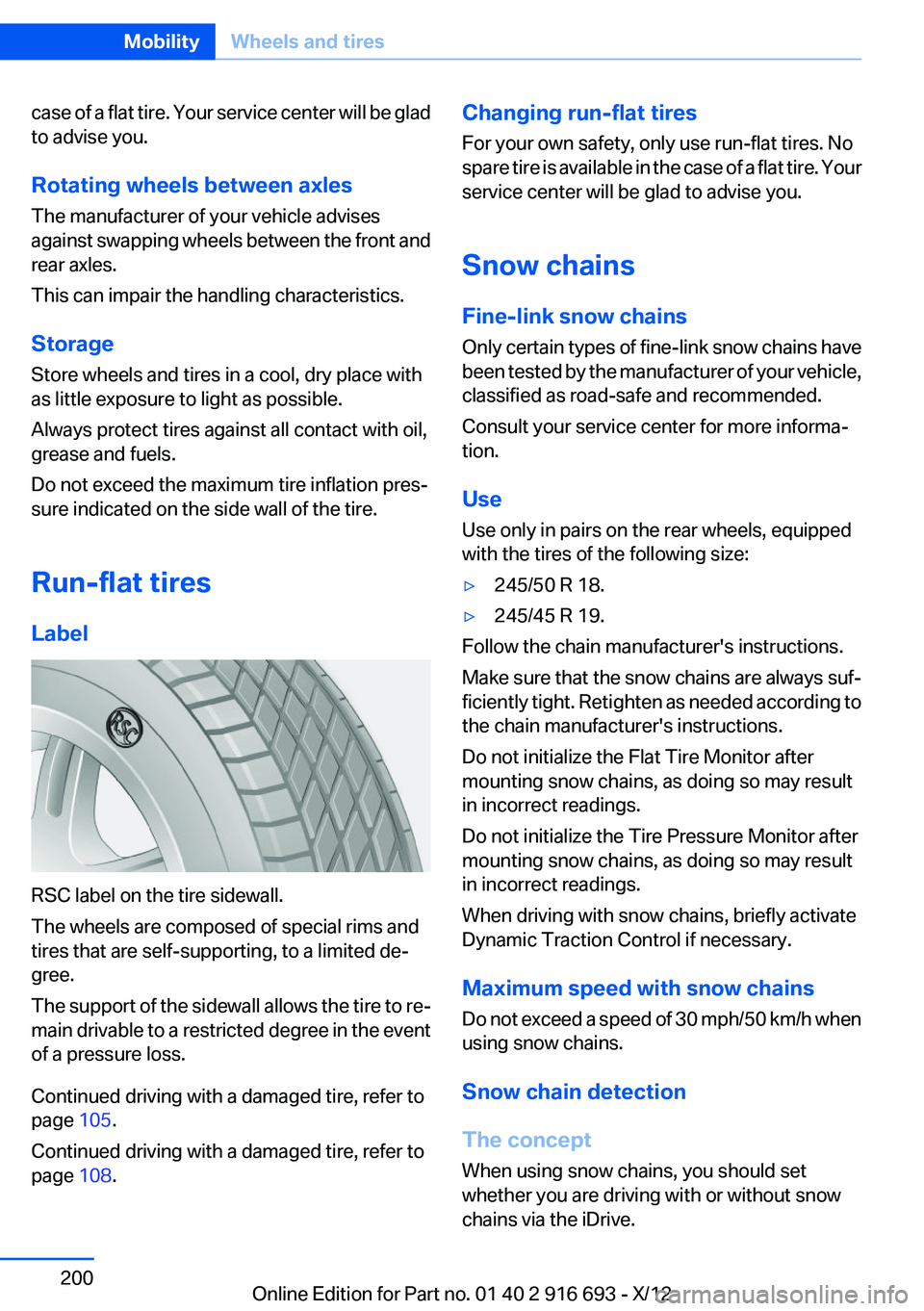
case of a flat tire. Your service center will be glad
to advise you.
Rotating wheels between axles
The manufacturer of your vehicle advises
against swapping wheels between the front and
rear axles.
This can impair the handling characteristics.
Storage
Store wheels and tires in a cool, dry place with
as little exposure to light as possible.
Always protect tires against all contact with oil,
grease and fuels.
Do not exceed the maximum tire inflation pres‐
sure indicated on the side wall of the tire.
Run-flat tires
Label
RSC label on the tire sidewall.
The wheels are composed of special rims and
tires that are self-supporting, to a limited de‐
gree.
The support of the sidewall allows the tire to re‐
main drivable to a restricted degree in the event
of a pressure loss.
Continued driving with a damaged tire, refer to
page 105.
Continued driving with a damaged tire, refer to
page 108.
Changing run-flat tires
For your own safety, only use run-flat tires. No
spare tire is available in the case of a flat tire. Your
service center will be glad to advise you.
Snow chains
Fine-link snow chains
Only certain types of fine-link snow chains have
been tested by the manufacturer of your vehicle,
classified as road-safe and recommended.
Consult your service center for more informa‐
tion.
Use
Use only in pairs on the rear wheels, equipped
with the tires of the following size:▷245/50 R 18.▷245/45 R 19.
Follow the chain manufacturer's instructions.
Make sure that the snow chains are always suf‐
ficiently tight. Retighten as needed according to
the chain manufacturer's instructions.
Do not initialize the Flat Tire Monitor after
mounting snow chains, as doing so may result
in incorrect readings.
Do not initialize the Tire Pressure Monitor after
mounting snow chains, as doing so may result
in incorrect readings.
When driving with snow chains, briefly activate
Dynamic Traction Control if necessary.
Maximum speed with snow chains
Do not exceed a speed of 30 mph/50 km/h when
using snow chains.
Snow chain detection
The concept
When using snow chains, you should set
whether you are driving with or without snow
chains via the iDrive.
Seite 200MobilityWheels and tires200
Online Edition for Part no. 01 40 2 916 693 - X/12